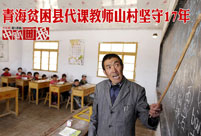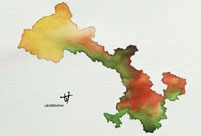 The life of a model: Not as glamorous as it seems
The life of a model: Not as glamorous as it seems
 Hello Kitty, happy 40th birthday!
Hello Kitty, happy 40th birthday!
 The Western Qing Mausoleum
The Western Qing Mausoleum
 Avant-garde approach to graduation photos
Avant-garde approach to graduation photos
 Early PLA posters, signatures of an era
Early PLA posters, signatures of an era
 First Russian Street in Tianjin open to public
First Russian Street in Tianjin open to public
 Motorcycle stunt on the Bund
Motorcycle stunt on the Bund
 French Spiderman Alain Robert climbs up Galaxy Hotel in Macao
French Spiderman Alain Robert climbs up Galaxy Hotel in Macao
 Africans in Guangzhou
Africans in Guangzhou
 Pole dancer shows strength and beauty up in the air
Pole dancer shows strength and beauty up in the air
LONDON, May 5 -- Maternal deaths and child mortality can be dramatically cut when efforts are made to improve services for mothers and children, a new research published by an international NGO said on Monday.
Launched in 2000, the annual report of State of the World's Mothers 2014, was released by the Save the Children, or Save the Children Fund, which focuses on millions of women and children living in communities affected by conflict, fragility and natural disasters and their everyday struggle to survive.
This report said more than 60 million women and children are in need of humanitarian assistance in 2014. Over half of maternal and child deaths across the world occur in crisis-affected places, while the majority of these deaths are preventable.
According to the Mothers' Index in the report, which assesses the well-being of mothers and children in 178 countries and regions, the top 10 countries are all European ones, such as Finland, Norway, Sweden, Iceland and the Netherlands, while the bottom 10 include Cote d'lvoire, Chad, Nigeria, Sierra Leone, the Central African Republic, Guinea-Bissau, Mali, Niger, the Democratic Republic of Congo, and Somalia.
The index assesses by five indictors, which include maternal health, children's well-being, educational status, economic status and political status.
The report said all the bottom 10 countries in the past 15 years have history of armed conflicts and are considered to be fragile states, some of the bottom countries suffer from recurring natural disasters.
China ranks at 61st, rising seven spots from last year. The report said Asian countries, such as China, Bangladesh and Nepal have made great achievement on reducing rates of child and maternal mortality since 1990.
Lynette Lim, spokesman of Save the Children, told Xinhua, in China, maternal mortality has been cut by almost half, child mortality decreased by nearly two-thirds, expected years of schooling increased by 3.6 years and gross national income per capita rose six-fold over the past 15 years.
"Much of this is investment in health care and education from the government at the national and provincial levels," she said.
Lim said wealth gap, spatial inequalities and malnutrition are still major problems in some Asian countries, including China, blocking the improvement of mothers and children's well-being.
However, the report shows the United States is slipping badly relative to rest of wealthy world in terms of how it cares for mothers.
The United States is among the countries that has made the least progress since 2000 on maternal and child survival, although it ranks at 31st.
In the United States, the report said, lifetime risk of maternal death has risen more than 50 percent since 2000 - from 1 in 3,700 to 1 in 2,400. Today, an American woman faces the same lifetime risk of maternal death as a woman in Iran or Romania.
It said the United States is also among the countries making the smallest strides in saving children's lives.
"Worldwide, women and children are often much more likely than men to die in a disaster, whether man-made or natural," said Jasmine Whitbread, chief executive of Save the Children.
"And each year, thousands more mothers and children die in conflict-settings than fighters do in battle. We urgently need to increase access to healthcare in places where state capacity is weak and conflict and insecurity is widespread," she said.
"All children have the right to survive, no matter where they are born. Many of these deaths are avoidable, and we can help to prevent them with the right plans and investments before, during and after a crisis has hit or fighting has intensified," she said.
The organization said national governments, donor countries, international agencies, the private sector and the civil society have a shared responsibility.
It said high quality health care and investment in women and girls' protection should be increased, long term resilience to minimize the damaging effects of crises on health and emergency interventions need to be built, while political engagement, adequate financing, as well as coordination and researches are essential.
 Solar halo occurs in Lhasa
Solar halo occurs in Lhasa High fashion trend welcomed by costumers in Changsha
High fashion trend welcomed by costumers in Changsha 17 years' teaching life in a remote village in Qinghai
17 years' teaching life in a remote village in Qinghai Beautiful Chinese-built roads in Africa
Beautiful Chinese-built roads in Africa The Western Qing Mausoleum
The Western Qing Mausoleum Overseas returnees strive for dreams in Beijing
Overseas returnees strive for dreams in Beijing Fried up: Chili pork bonanza in Central China
Fried up: Chili pork bonanza in Central China Hand-painted maps go viral online
Hand-painted maps go viral online 4th Beijing Int'l Film Festival ends
4th Beijing Int'l Film Festival ends 'African Street' in Guangzhou
'African Street' in Guangzhou Special operation members in comprehensive training
Special operation members in comprehensive training Cute Shaolin boy melts the hearts of millions
Cute Shaolin boy melts the hearts of millions Giant panda Sijia is back to happy life
Giant panda Sijia is back to happy life Richest Chinese of 2014: half from the mainland
Richest Chinese of 2014: half from the mainland Chengdu - laid-back lifestyle makes happiest city
Chengdu - laid-back lifestyle makes happiest cityDay|Week|Month